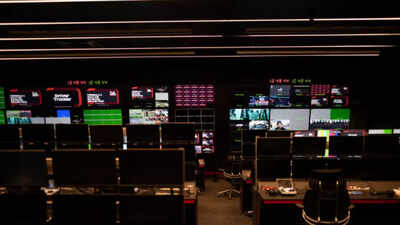Processing data at F1 speed: How Lenovo’s tech muscle powers F1’s thrills

Formula 1’s 75th season is in full swing, with three races already completed – the most recent being the Japanese Grand Prix, where Red Bull’s Max Verstappen clinched a record fourth consecutive win at the iconic Suzuka Circuit. We were there at the track on Friday to witness the free practice sessions up close. As part of a special visit organised by Lenovo, we also got rare behind-the-scenes access to understand how the global tech giant is helping power Formula 1 from the inside out. While the high-speed on-track drama is what grabs headlines, it’s the robust technology working silently in the background that keeps the show running and Lenovo is at the heart of it. How? We explain here.
Lenovo’s partnership with F1
Lenovo has been associated with Formula 1 since 2022. But from 2024, the company has stepped up its involvement as the sport’s Global Partner and Global Technology Partner. As part of this tie up, the company now provides everything from high-performance ThinkPad laptops, edge computing devices to powerful HPC servers to F1. These equipment and services support F1’s broadcast operations, data processing, and also contribute to its 2030 sustainability goals. Additionally, Motorola, a Lenovo company, has also come on board as F1’s Global Smartphone Partner starting from the 2025 season.
Behind the broadcast: Taking F1 from circuit to screen
Every Formula 1 race generates a staggering amount of data. During our visit, we learned that more than 500 TB of data are transferred from the racetrack to Formula 1’s Media and Technology Centre (M&TC) in Biggin Hill, UK, over a typical race weekend. This includes live video feeds, car telemetry, timing data, and more. Now, all of this is made possible by Lenovo’s infrastructure. A Formula 1 at the Event Technical Centre explained that it takes just 233 milliseconds to transfer data from the ETCs across the race calendar to MTC. Interestingly, 90 percent of the equipment used for broadcasting are from Lenovo at both the centres.

Inside the Event Technical Centre (ETC).
Managing this volume of data is no easy feat. But Lenovo’s technology has helped F1 transition to a more efficient remote operations model. What used to require multiple 40-foot air freight containers full of computing and broadcast hardware has now been streamlined into a virtualised system. Lee Wright, Head – IT Operations, told us in a media roundtable in Nagoya, Japan “We used to ship many containers of equipment. Now, with Lenovo, we’ve moved to a remote setup, replacing over 200 physical workstations with a more compact, virtual solution.”

Media and Technology Centre (M&TC) in Biggin Hill, UK.
This setup allows F1 to split the work between the trackside Event Technical Centre (ETC) and the central M&TC. It also means that this approach has reduced the number of people and amount of equipment that needs to travel to each venue, contributing to both efficiency and sustainability.
Real-time computing at the edge
On the ground, Lenovo’s edge computing devices help collect and process data right at the racetrack. This real-time analysis is crucial. This data may include telemetry for teams, or engaging graphics for fans watching at home. These devices reduce latency and improve the accuracy of data, enabling engineers to make quick decisions during races where even milliseconds matter a lot.

F1 uses fibre-optic networks for transmitting data due to their speed and reliability. Given the global nature of the sport and the unique challenges of each location, having a consistent and robust setup is critical – something Lenovo says that it helps deliver at every race.
Lenovo also powers the live broadcasting of races. The company has employed its hybrid AI-enabled PCs that work in tandem to stabilize camera angles to render real-time graphics. For example, if a camera shot is slightly off or distorted, Lenovo’s systems can auto-correct it in real time, ensuring that what viewers see on screen is sharp and accurate.

This entire operation relies on up to 7.5 Gbps of peak bandwidth and dual 10-gigabit fibre connections, ensuring high-speed data transfer with minimal delay.
How Lenovo is contributing to F1’s sustainability efforts
With its push towards remote operations, Lenovo has also helped Formula 1 reduce its carbon footprint. Fewer people and less hardware travelling to races means lower emissions. In fact, we were told that the number of staff required trackside has dropped from 250 to 130, without affecting performance.
Behind the scenes, Lenovo’s virtual infrastructure is now running 200 virtual machines, powered by 448 CPU cores and over 3.5 TB of RAM.

Another major contribution towards sustainability comes in the form of Lenovo’s Asset Recovery Services (ARS). It ensures that older or damaged equipment isn’t wasted. Instead, devices are collected, refurbished, and repurposed, thus extending their life and reducing e-waste.
Built to handle the heat (and the cold)
Formula 1 is a tough environment, and the hardware used has to endure extreme conditions. The hardware often endures scorching heat and freezing temperatures besides experiencing constant vibration during transport. Lenovo’s devices, including Motorola smartphones, are tested to handle this stress and are used for real-time communication across continents like between teams at Suzuka in Japan and HQ in the UK.

With its expanded partnership, Lenovo will also act as a title sponsor for select races, including the recently-concluded Japanese and upcoming Hungarian Grands Prix, and will continue to support over 600 F1 employees globally with its technology.

Lenovo has been instrumental in helping Formula 1 collect and transfer data in real-time with minimal latency, enabling the delivery of engaging, live race coverage to over 180 countries and more than 750 million fans worldwide. During our visit to Japan, we got a deeper understanding of how technology plays a crucial role – not just on the track, but also behind the scenes and across borders. It’s this seamless tech-driven ecosystem that delivers the thrilling F1 content we’ve come to love in India, where the sport’s fanbase has been growing rapidly.





